Netflix Streaming Issues
In the era of digital entertainment, Netflix has become a leading contender, revolutionizing the way we consume television shows and movies. With millions of subscribers globally, Netflix offers an unparalleled convenience that allows viewers to access a large library of content with just a few clicks. However, despite its massive popularity and ease of use, subscribers often encounter various Netflix streaming issues that can hinder their viewing experience. From frustrating buffering delays to sudden streaming dropouts, these problems can detract from the seamless enjoyment of your favorite shows and movies. Understanding these problems with streaming Netflix is crucial for anyone looking to ensure a smooth, uninterrupted viewing experience. The common Netflix streaming issues vary widely but tend to disrupt the viewing process significantly, leading to annoyance and dissatisfaction.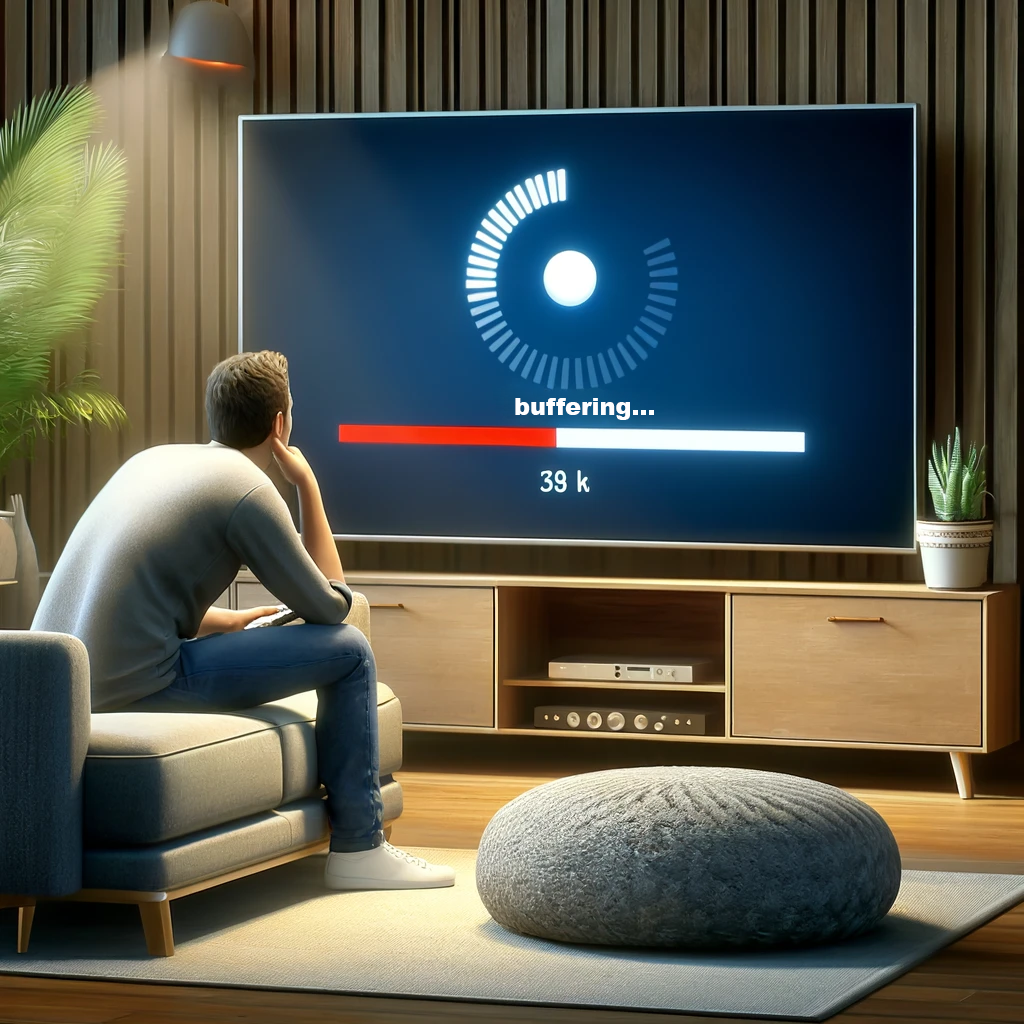
In this blog, we will explore the most prevalent problems with streaming Netflix, offering insights and solutions to help you overcome these challenges. Our aim is to arm you with the knowledge and tools necessary to tackle any Netflix streaming issues head-on, ensuring that your binge-watching sessions remain uninterrupted. So, whether you’re facing slow load times or persistent errors, stay tuned as we uncover the secrets to a smoother Netflix experience.
Understanding Netflix Streaming Issues
Streaming on Netflix, much like any other online streaming service, relies heavily on a stable and speedy internet connection. At its core, streaming is the process of seeing video content without having to download it completely beforehand. Instead, data packets are sent from the server to your device, allowing for real-time viewing. However, this seemingly straightforward process is influenced by a broad range of factors causing issues such as Netflix slow streaming or not streaming.
Netflix slow streaming often occurs when there isn’t enough bandwidth to handle the video quality settings you’ve selected in Netflix, which is designed to automatically adjust video quality based on your connection speed. However, when the bandwidth is limited, you may notice a drop in video quality or frequent pauses for buffering—the infamous spinning wheel that can disrupt your viewing experience. This is a primary symptom of Netflix slow streaming, manifesting as delayed video start, lowered resolution, and intermittent stops.
Several factors can affect your streaming quality:
-
Internet Speed and Bandwidth:
The most crucial factor is the speed of your internet connection. Netflix suggests speed of at least 3 Mbps for SD quality, 5 Mbps for HD, and 25 Mbps for Ultra HD content. If many devices are connected to your network and consuming bandwidth, your streaming quality will suffer.
-
WiFi Signal Strength:
Even with a high-speed internet plan, a weak WiFi signal can cause Netflix slow streaming. Distance from the router, physical obstructions, and interference from other devices can all degrade signal quality.
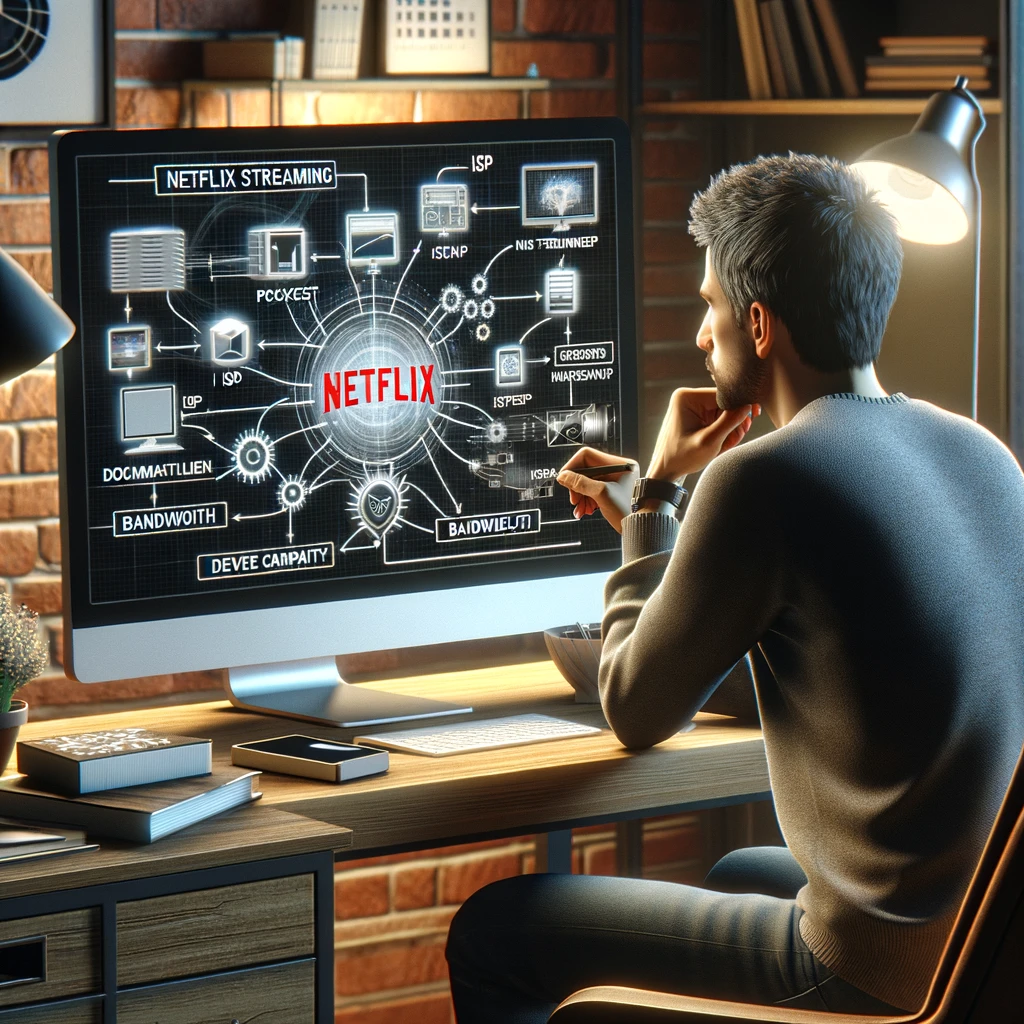
-
Hardware and Software Configuration:
The device you’re using to stream Netflix can also impact performance. Older hardware may not support higher resolutions, and outdated software may cause problems with compatibility and slower performance.
-
Server and Network Congestion:
At times, the issue might not be on your end at all. Server problems or high traffic on the network can slow down streaming speeds, leading to Netflix slow streaming .
Understanding these factors is important for diagnosing and addressing Netflix streaming issues. By identifying what might be causing Netflix slow streaming, you can take appropriate steps to optimize your setup and improve your streaming experience. In the next sections, we’ll explore how to diagnose these issues accurately and provide effective solutions to enhance your Netflix viewing sessions.
Common Netflix Streaming Issues & Their Causes
Navigating the complexities of streaming can sometimes feel as dramatic as the plots in your favorite Netflix series. Users often face several disruptive issues that can range from Netflix not streaming at all to stuttering when streaming. Understanding the root causes of these problems is the first step towards finding a solution.
-
Netflix Buffering or Freezing Issue
One of the most common complaints among streaming users is buffering. This occurs when there isn’t enough downloaded data for the video to play smoothly, causing the video to pause and buffer. Buffering usually points to an issue with internet bandwidth. If your internet connection is too slow or if too many devices are connected at once, your ability to stream seamlessly is compromised. To know more about this issue and it’s solution, you can read our in-depth blog on Netflix Keeps Freezing.
-
Netflix Low Video Quality
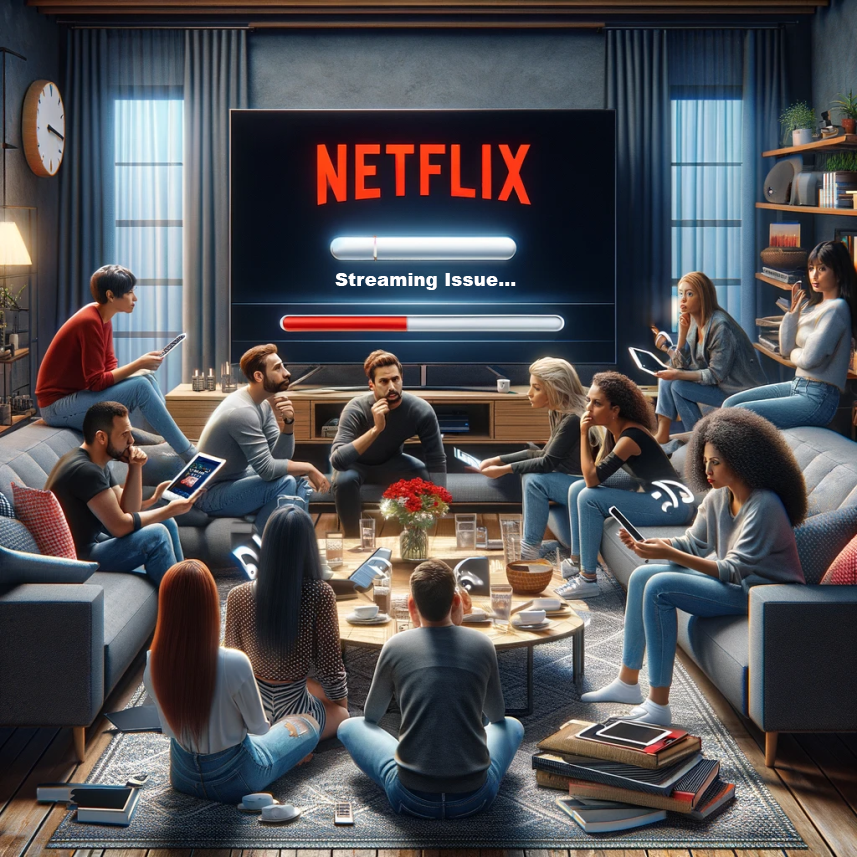 Another prevalent issue is unexpectedly low video quality, where videos look pixelated or blurry. This often occurs when Netflix automatically adjusts the streaming quality lower to match the available bandwidth. It’s a common scenario when Netflix streams slow, attempting to provide uninterrupted viewing despite a poor connection.
Another prevalent issue is unexpectedly low video quality, where videos look pixelated or blurry. This often occurs when Netflix automatically adjusts the streaming quality lower to match the available bandwidth. It’s a common scenario when Netflix streams slow, attempting to provide uninterrupted viewing despite a poor connection.
-
Unexpected Errors by Netflix
Viewers might also encounter various error messages, such as the dreaded “Netflix Error 1011” or “Netflix Error 3010.” These errors typically indicate issues ranging from network connectivity problems to data on your device needing to be refreshed. Each error code provides insight into a different issue, which can often be resolved with specific troubleshooting steps.
-
Device-Specific Netflix Streaming Issues
Problems may also arise that are specific to the device being used. For example, Netflix stuttering when streaming is more common on certain devices than others. Older smart TVs, for instance, might struggle to keep up with streaming high-quality content due to outdated hardware. Similarly, specific settings on gaming consoles or peculiarities in how different operating systems handle data can lead to Netflix streaming issues.
-
Server and Network Congestion by Netflix
Lastly, server issues and network congestion can play significant roles in degrading streaming quality. During peak hours, when millions of users log on to watch, you might experience Netflix stuttering when streaming or a complete inability to stream content, commonly noted as Netflix not streaming.
Understanding these common issues helps in diagnosing Netflix streaming issues and applying the right solutions. In the next section, we will delve into how to diagnose these Netflix streaming issues effectively, so you can get back to enjoying your binge-watching without interruptions.
How to Diagnose Netflix Streaming Issues
When your binge-watching marathon hits a snag due to Netflix streaming issues, it’s important to know how to quickly diagnose the problem so you can get back to enjoy your favorite shows and movies. There are several effective methods and tools that can help you identify and troubleshoot the specific issues affecting your streaming experience. Here’s a step-by-step guide to diagnosing Netflix streaming issues: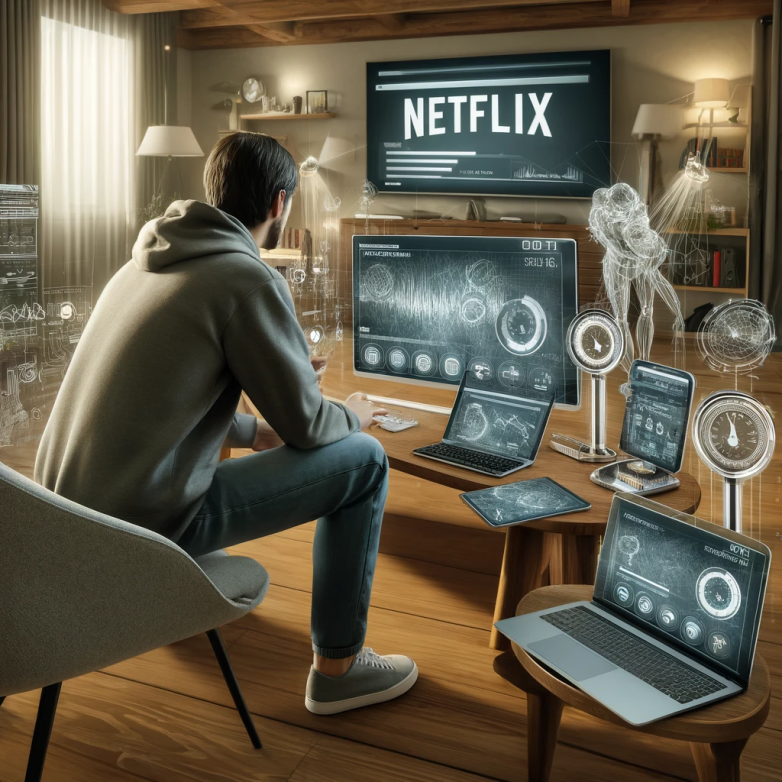
-
Check Your Internet Connection
The first step in troubleshooting any Netflix streaming issues is to check the speed of your internet connection. A slow or unstable internet connection is often the root cause of many streaming problems. You can use various online speed tests like Speedtest by Ookla, Fast.com (which is actually powered by Netflix), or any other reliable internet speed test tool.
-
Evaluate Bandwidth Consumption
If your speed test shows adequate speed but you’re still experiencing Netflix streaming issues, check how much bandwidth is being used on your network. High traffic from other devices or applications can consume a significant portion of your bandwidth, leaving insufficient resources for streaming Netflix. Ensure that other devices are not performing bandwidth-intensive tasks such as downloading large files or streaming other media simultaneously.
-
Test on Different Devices or Browsers
Sometimes, Netflix streaming issues can be isolated to a particular device or browser. Try streaming Netflix on a different device within the same network environment to see if the issue persists. For example, if you’re experiencing problems on your smart TV, try streaming on your smartphone or a laptop. Similarly, if you are using a browser to stream, try switching between browsers (from Chrome to Firefox, for example) or clearing the browser cache.
-
Analyze WiFi Signal Strength
WiFi signal strength can significantly affect streaming quality. If you use a wireless connection, check the WiFi signal strength on your device. A weak signal may lead to Netflix streaming issues. You can improve your WiFi signal by moving closer to router or removing any physical obstructions. Alternatively, consider using a wired connection to directly link your device to the router via an Ethernet cable.
-
Check Netflix’s Server Status
Occasionally, the problem might not be on your end. It’s possible that Netflix’s servers are down or experiencing issues. You can check for any reported server outages on websites like Downdetector, which tracks service outages and provides real-time reports. If there are widespread problems, the best course of action is to wait until Netflix resolves these issues.
By following these steps, you can check and often resolve many of the common Netflix streaming issues that interrupt your viewing experience.
Solutions to Improve Netflix Streaming Quality
When you encounter Netflix slow streaming, it can dampen your entertainment experience. Fortunately, there are several effective strategies to improve the streaming quality of Netflix. From improving your internet speed to tweaking Netflix’s settings, these solutions can help ensure a smoother, higher quality viewing experience.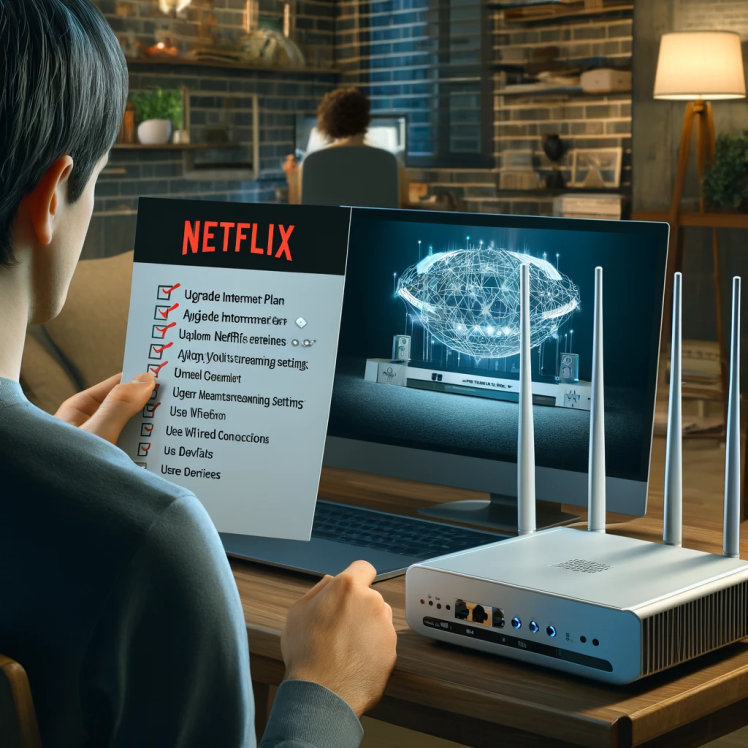
Improve Internet Connectivity for Netflix
Improving your internet speed is pivotal when you face Netflix streaming issues. Here are a few ways to boost your internet connectivity:
-
Upgrade Your Internet Plan:
If your current internet speed does not meet Netflix’s recommendations (3 Mbps for SD, 5 Mbps for HD, and 25 Mbps for Ultra HD), consider upgrading to a higher-speed internet plan.
-
Optimize Router Placement:
The location of your WiFi router significantly affects signal strength. Place your router in a central location away from walls and obstructions to improve coverage throughout your home and avoiding Netflix streaming issues.
-
Limit Bandwidth Usage:
Ensure that other devices and applications are not consuming large amounts of bandwidth when you are streaming Netflix. Restricting the use of bandwidth-heavy applications can alleviate Netflix streaming
-
Use a Wired Connection:
A wired connection via Ethernet can give a more stable and faster internet connection compared to WiFi, significantly improving streaming quality.
Adjust Netflix Streaming Settings
Adjusting the streaming settings within your Netflix account can also address Netflix slow streaming:
-
Lower the Playback Settings:
You can manually adjust the playback quality settings in your Netflix account to a lower level to reduce buffering. Navigate to Account > Profile & Parental Controls > Playback settings and select a lower data usage option.
-
Turn Off Auto-Play:
Disabling auto-play features can also help manage bandwidth usage more effectively, especially if you are prone to leaving Netflix running without actively watching.
Update and Maintain Your Devices for Netflix
Keeping your devices updated is crucial in preventing Netflix streaming issues:
-
Update Your Device’s Firmware or Software:
Regular updates often include performance enhancements and bug fixes that can improve streaming capabilities.
-
Close Unnecessary Apps:
On devices like smartphones, tablets, or even smart TVs, close other applications that may be running in the background to free up resources for Netflix.
Advanced Troubleshooting for Netflix Streaming Issues
If basic adjustments don’t resolve the Netflix streaming issues, consider these advanced troubleshooting techniques:
-
Check for Interference:
Other electronic gadgets like cordless phones or microwave ovens can affect WiFi signals causing Netflix streaming issues. Remove or turn off these devices to see if your streaming improves.
-
Change Your WiFi Channel:
Using tools like WiFi Analyzer, find a less congested channel for your WiFi network to avoid interference from neighbors’ networks.
-
Reboot Your Equipment:
Sometimes, simply restarting your router, modem, and the streaming device can resolve streaming issues by clearing out any temporary glitches.
These proactive steps address the most common factors behind Netflix streaming issues and ensure that Netflix streams slow less frequently, allowing you to enjoy your favorite content without interruption.
Preventing Future Netflix Streaming Issues
To ensure a consistently high-quality streaming experience on Netflix and to minimize the chances of encountering Netflix streaming issues, adopting proactive maintenance strategies and best practices is essential. Regular maintenance not only helps in avoiding the problems with streaming Netflix but also enhances overall system performance. Here are several effective strategies to help prevent future streaming disruptions: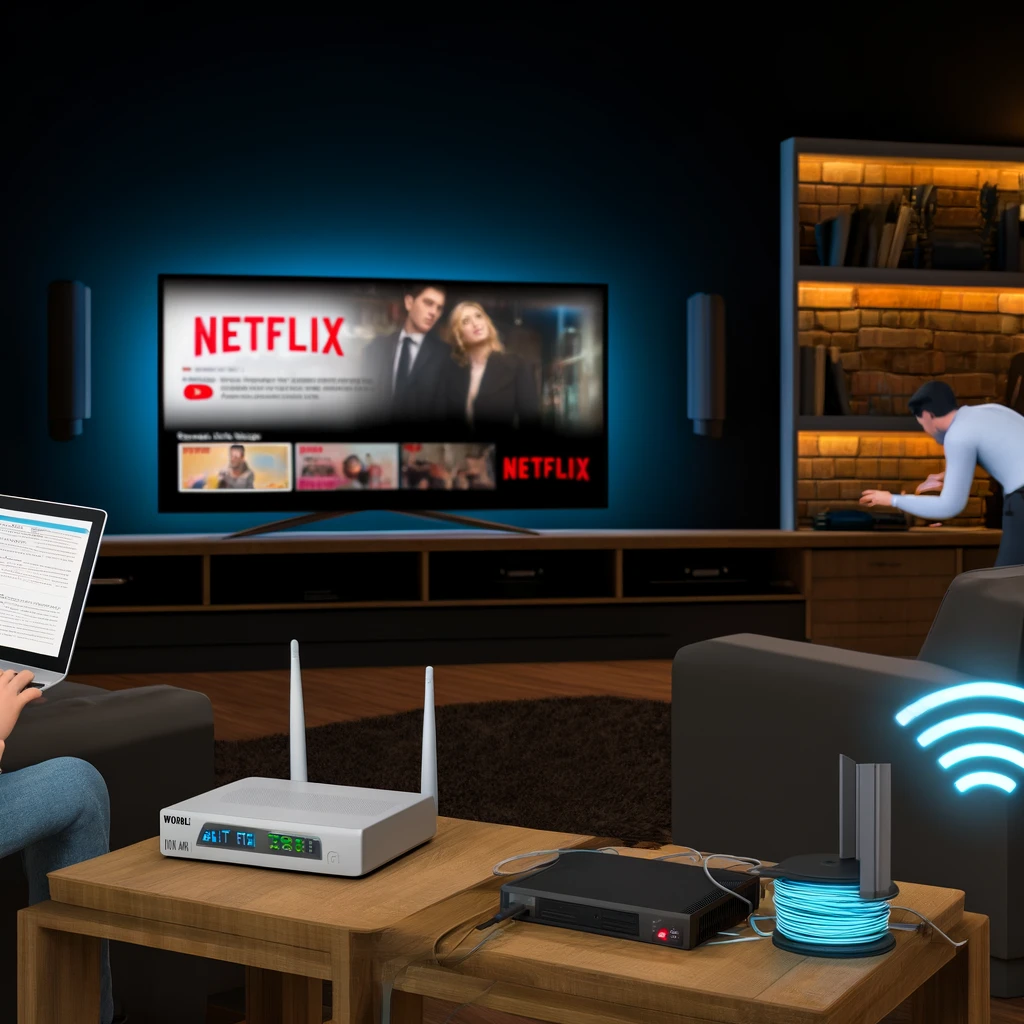
Regular Internet Speed Checks for Netflix Streaming Issues
Consistently monitoring your internet speed is a crucial step in preventing Netflix streaming issues. Regular speed tests can help you gauge if you’re consistently getting the bandwidth you’re paying for and if it’s sufficient for high-quality streaming.
Keep Technology Updated to Prevent Netflix Streaming Issues
Outdated hardware and software can contribute significantly to problems with streaming Netflix. To avoid such issues, it is important to:
-
Update Your Streaming Devices:
Ensure that your smart TVs, gaming consoles, streaming sticks, or any other devices used for Netflix are regularly updated with the latest firmware. These updates can fix known bugs, improve device performance, and sometimes even enhance security features.
-
Update Networking Equipment:
Regular updates for your modem and router can improve their efficiency and compatibility with newer devices and technologies. Check for firmware updates from your internet service provider or router manufacturer.
Optimize Home Network to Prevent Netflix Streaming Issues
Optimizing your home network can prevent many common Netflix streaming issues:
-
Secure Your WiFi Network:
An unsecured WiFi network can be used by unauthorized users, which may congest your network and slow down your streaming speed. Ensure your WiFi is password-protected and use strong, hard-to-guess passwords.
-
Use Quality of Service (QoS) Settings:
Many modern routers allow you to prioritize traffic to particular devices or services. Setting a higher priority for streaming services like Netflix can ensure that your network allocates adequate bandwidth for streaming, even when multiple devices are connected.
-
Regularly Reboot Your Network Devices:
Periodically rebooting your modem and router can clear cache and refresh your connection to your ISP, which can resolve hidden Netflix streaming issues and improve performance.
Scheduled Device Maintenance for Netflix
Set a regular schedule to check and maintain all devices involved in streaming:
-
Clean Device Storage:
Over time, devices accumulate cache and data that can slow them down. Regularly cleaning out the cache and managing the storage of your streaming devices can keep them running smoothly.
-
Physical Maintenance:
Keep your devices free of dust and ensure they are well-ventilated to prevent overheating, which can degrade performance and lead to Netflix streaming issues.
By integrating these practices into your routine, you can significantly reduce the likelihood of encountering problems with streaming Netflix.
FAQs
Q1. What causes Netflix Slow Streaming?
- A1. Netflix streams slow due to insufficient internet bandwidth. If other devices are using the network or your plan doesn’t meet Netflix’s minimum speed requirements, you may experience slow streaming.
Q2. Why am I experiencing Netflix Stuttering When Streaming?
- A2. The issue of Netflix stuttering when streaming can occur due to fluctuating internet speeds, inadequate WiFi signal strength, or congestion on your home network.
Q3. How can I resolve Netflix Not Streaming on my device?
- A3. If Netflix not streaming issue occurs, check your internet connection and speed first. Restarting your device and router can also help restore streaming capabilities.
Q4. What should I do if my Netflix Streams Slow on a Smart TV?
- A4. If Netflix streams slow, improve it by checking your internet connection speed, reducing the number of devices connected to your network, and adjusting the streaming quality settings in your Netflix account.
Q5. How can I fix problems with Streaming Netflix due to network congestion?
- A5. To fix issues problems with streaming Netflix due to network congestion, try streaming during off-peak hours, upgrade your internet plan for higher speeds, or set your router to prioritize Netflix traffic using QoS settings.
Q6. How can I Stream Netflix from phone to tv?
- A6. To stream Netflix from phone to TV, ensure both devices are on the same WiFi network. Use a Chromecast, Apple TV, or a smart TV app to mirror or cast the Netflix content from your phone to the TV.
Q7. Why does Netflix Streaming issues occur more frequently during peak hours?
- A7. Netflix streaming issues occurs during peak hours as more users are online during that period, which can lead to increased traffic on both your local network and Netflix’s servers, resulting in streaming issues.
Q8. Can hardware issues cause Netflix Streaming issues?
- A8. Yes, outdated or malfunctioning hardware can contribute to Netflix streaming issues. Ensure your streaming device, whether it’s a smart TV, smartphone, or game console, is capable of handling the streaming requirements for Netflix.
Conclusion
Throughout this article, we have looked at various aspects of diagnosing and resolving Netflix streaming issues, underscoring the importance of maintaining an optimal viewing experience. It’s clear that while Netflix provides an unmatched platform for entertainment, the enjoyment can be significantly marred by streaming problems. However, with the right knowledge and tools, most Netflix streaming issues can be effectively managed or completely resolved.
We began by understanding the fundamental workings of streaming technology and moved on to identify common Netflix streaming issues like buffering, low video quality, and unexpected error codes. Armed with this knowledge, we discussed detailed diagnostic steps to pinpoint the specific causes of your streaming troubles. Following diagnosis, we provided practical solutions aimed at enhancing your Netflix streaming quality, which included tips on internet connectivity, device maintenance, and network optimization.
Furthermore, to ensure long-term improvements, we emphasized the importance of preventive measures and regular maintenance. These steps are crucial in not only fixing but also preventing future Netflix streaming issues, thereby making your streaming experience smoother and more enjoyable.
In closing, resolving and preventing Netflix streaming issues is paramount for anyone looking to enjoy Netflix to its fullest. With the strategies outlined in this blog, you are now better equipped to tackle any streaming challenges that come your way.
To know more about Netflix Streaming Issues and solutions, visit our Netflix Support Page.


Mary campbell
I’m trying to stream Netflix from my phone to my TV, but I keep running into Netflix streaming issues. What could be causing these issues, and how can I fix them to ensure a smoother streaming experience?
Support Admin
When attempting to stream Netflix from your phone to your TV and experiencing Netflix streaming issues, there are several factors to consider. First, connectivity is key; ensure that both your phone and TV are connected to the same WiFi network. Differences in network settings or insufficient bandwidth can disrupt the streaming process. If you’re using a streaming adapter like Chromecast or AirPlay, check that the firmware is up to date. Interference from other wireless devices can also degrade the WiFi signal. To resolve these issues, try moving your router to a more central location, reduce traffic on your network by disconnecting idle devices, and consider using a 5GHz WiFi band if available, which is generally less congested than the 2.4GHz band.
Nancy hill
Why does my Netflix often end up not streaming or stuttering when streaming on my smart TV, and what are the best steps to troubleshoot these Netflix streaming issues?
Support Admin
If you’re facing problems where Netflix not streaming or Netflix stuttering when streaming on your smart TV, several troubleshooting steps can be vital. Firstly, verify your internet connection’s speed to ensure it meets the minimum requirements for the content quality you are trying to watch. Slow speeds or unstable connections are common culprits. Furthermore, your smart TV itself could be a factor—older models may not have the processing power needed for smooth streaming, particularly at higher resolutions. Ensure your TV’s firmware is up to date, as manufacturers often release performance improvements. If issues persist, reset your WiFi connection or connect your TV directly to the router with an Ethernet cable for a more stable internet connection.